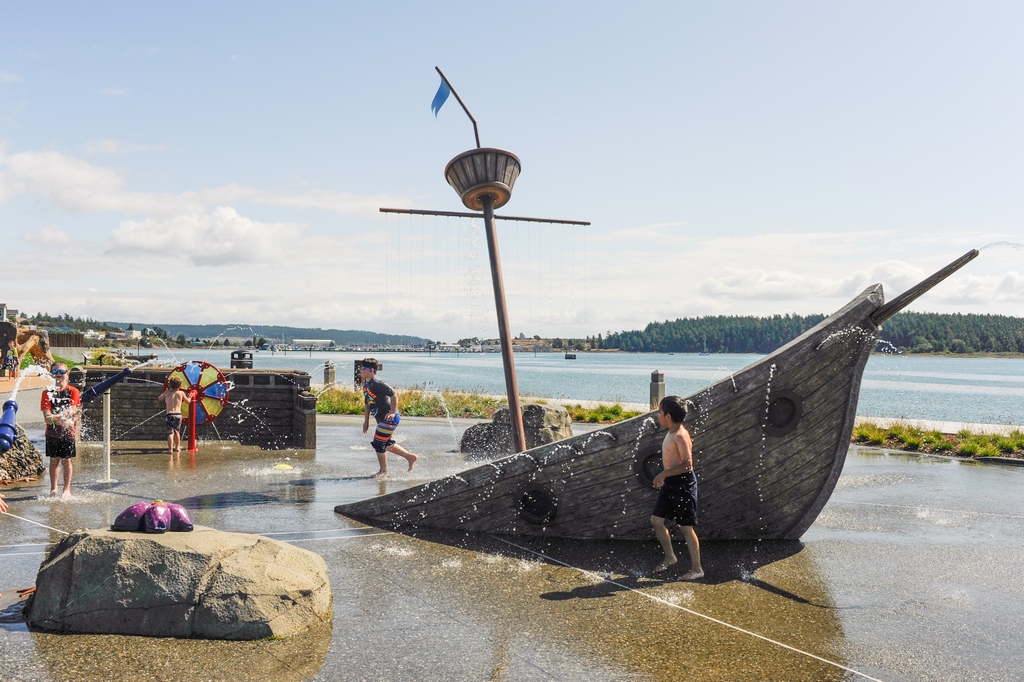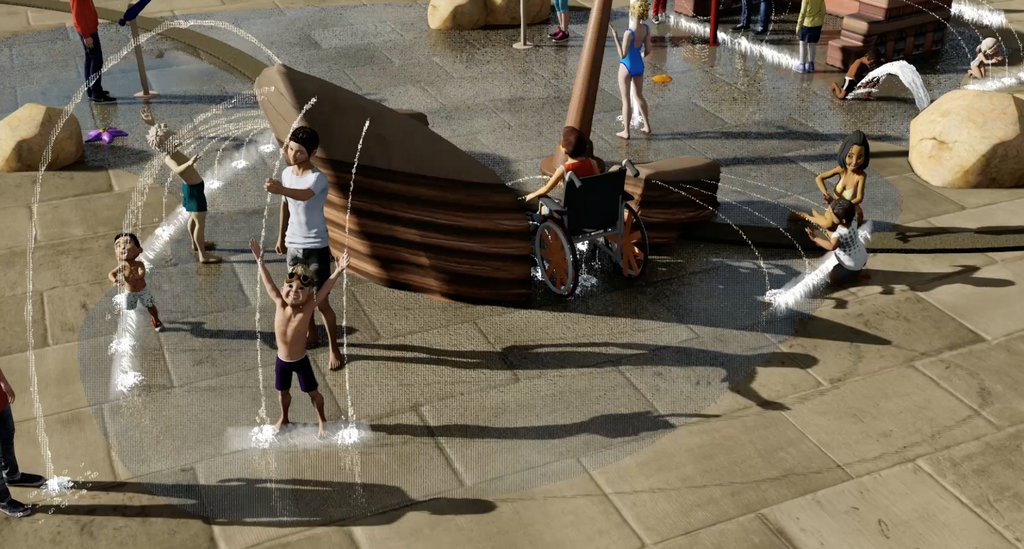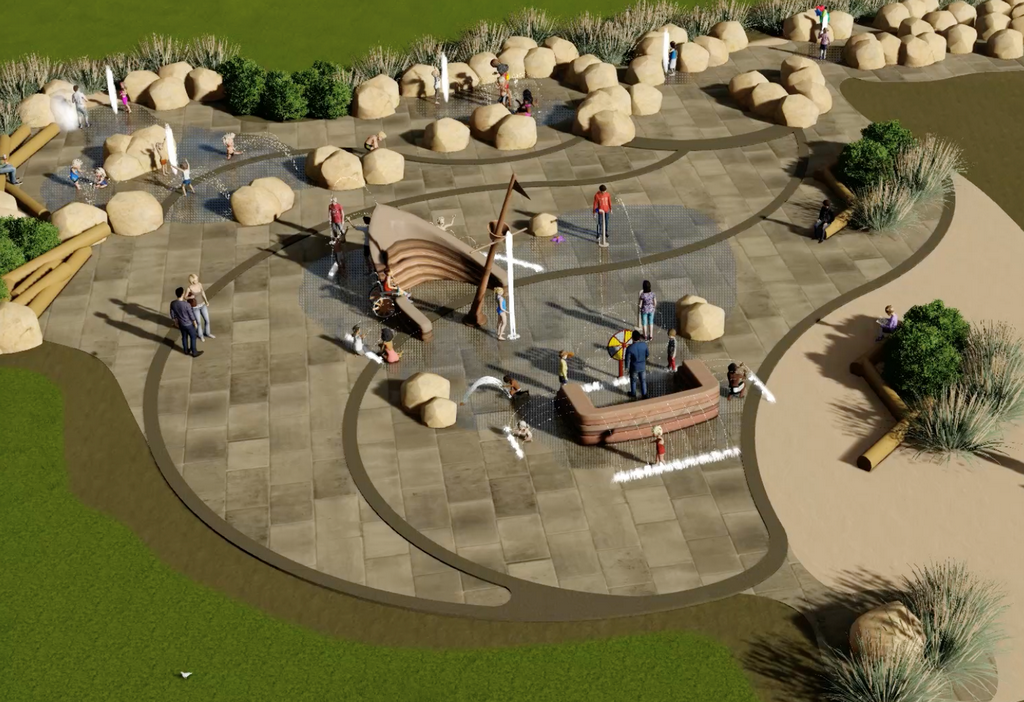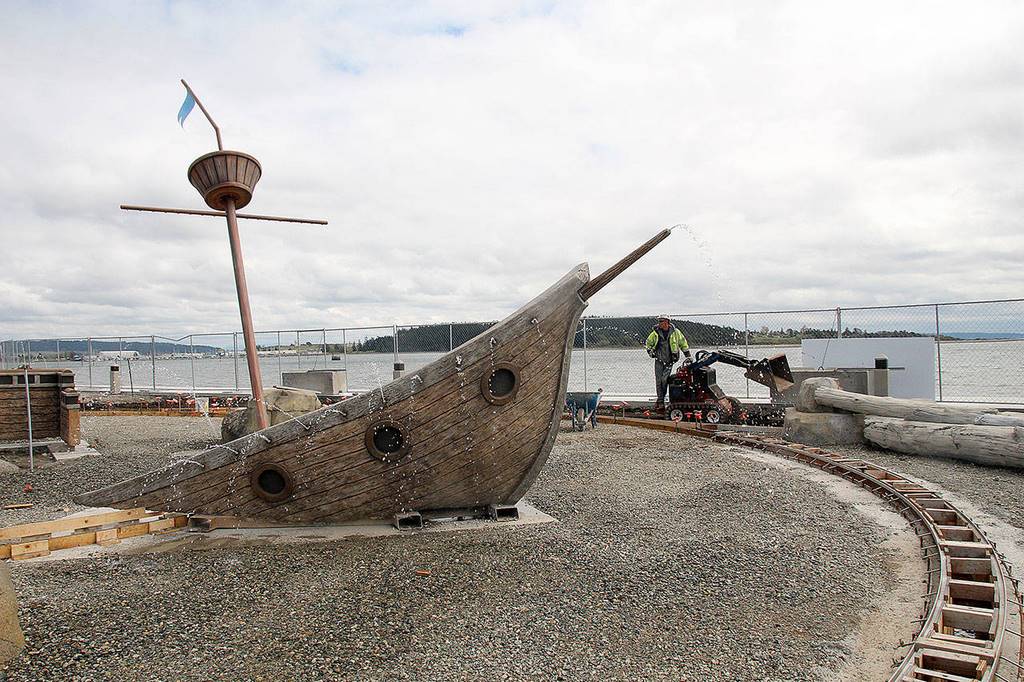A Beautiful Wreck

Creating custom interactive water features often involves not only understanding the needs of community stakeholders, but also the character and history of the place itself.
That was certainly the case at Windjammer Park, a 28.5-acre waterfront recreational area located in the picturesque town of Oak Harbor on Whidbey Island in Washington State.
Nestled on the shores of the majestic Puget Sound, locals take tremendous pride in their exquisite surroundings. It was not surprising the City of Oak Harbor was looking for a themed concept that reflected the community’s history and aquatic culture. For hundreds of years, ships transporting explorers and merchandise have sailed through the waters of the Puget Sound and Oak Harbor, along with fisherman, Navy vessels and the occasional pirate. So, it was only natural to gravitate toward the concept of an old shipwreck as the focal point of the splash pad.
The work was part of larger waterfront renewal development, known as the Clear Water Facility Project, which also included the complete replacement and modernization of an adjacent water-treatment facility, a long-needed infrastructure upgrade for the community. The park itself underwent a complete renovation with the splash, which now serves as one of the “flagship” attractions in what now stands as an inviting destination for locals and visitors alike.
A TEAMING SHORE
Water Odyssey worked closely with consultants at Northwest Playground Equipment and GreenWorks Landscape Architecture & Design Group to produce this unique, custom shipwreck concept. It’s a charming and clever design, featuring a half-buried hull, mast, sails represented by sheeting water, water cannons and an array of ocean-themed peripheral features.
Together with city officials, our team worked to create a scene that tells the story of partially sunken sailing ship slowly disappearing into the shore, or more accurately the splash-pad surface. Water emanates through what appears to be the hull’s distressed wooden structure, something that can actually happen in real wooden shipwrecks.
| Designing interactive water features begins with understanding user needs and inclusivity. In this case, the wreck at Oak Harbor offers a range of experiences within what appears a relatively simple scene. |
The wreckage consists of a derelict upturned prow and severed stern along with a mast and crow’s nest. Natural-looking rock formations, logs and driftwood accented by realistic starfish and mussel details, all spraying water, were also part of the themed aquatic play area.
Once the city agreed to the design motif, we immediately knew it would be important that this ill-fated vessel look weathered, as though it’s being reclaimed by nature. The city also wanted the shipwreck and surrounding various features to blend into — and not obstruct — views of the area’s natural vistas. And, it all needed to come together to create an attractive public space that invites visitors to linger and play.
The structure is prominent in the landscape, with a mast height of 18-feet high, which serves as a conveniently visible landmark in the sprawling shoreline park. The circulation system moves about scant 2,500 gallons of water flowing throughout the splash play area that includes a variety of rain curtains, spray effects and water cannons. (One of the beauties of splash pads is that they don’t require much water compared to other watershapes.)
Although there is no pretense that it’s an actual shipwreck, per se – it’s quite obviously a wet playground – the detailing is nonetheless surprisingly convincing. The resulting vignette depicts a wreck from long ago that is now being overtaken by sea life, rocks and driftwood, and it just happens to be a great place to cool off and have some fun.
We are always striving to create inclusive environments, and are equally dedicated to full compliance with all applicable ADA regulations. Our design team included a wheelchair access point directly through the broken hull. The water effects flowing through the edges of the hull-break reward everyone who inspects the wreck, whether on foot on in a wheelchair. The water-spraying system is computerized and allows for different “play scenarios” for a wide range of ages and abilities, further amplifying the inclusivity factor.
FANCIFUL FABRICATIONS
Our work on the project included a 3D animation in which we placed each of the individual pieces of the splash pad, creating an interactive walk-thru that enables the client to visualize how the different elements would look in spatial context.
The animated sequence our designers created effectively depicted the water features in action to illustrate the flows and sprays from each of the pieces and how they would create different levels of interactive experience. The initial design process also included creating a color palette to ensure every chromatic detail was in line with the client’s expectations for the overall look of the project.
| It’s important to get the clients and the entire project team on board with the design concept. We use a variety of digital illustrations and animations to enable everyone involved to visualize the spatial relationships, scale, water effects and organization of the space. |
Once the client was happy with the design, scale and color scheme, we moved into the fabrication stage of the phase. As is true on the vast majority of our projects, we used our proprietary glass-fiber-reinforced concrete (GFRC) process, which we’ve found offers a number of advantages that are well-suited to these types of applications.
The GFRC process creates what we call “thin shell” components that are lighter weight, with high tensile strength and sculptural versatility. Fiber strands are a part of the concrete mixture that enhance the strength and durability. We apply it by hand or by pump, where the final sculpting and detailing is done, where it conforms to any shape and textural detail, from rocks and wood, to ornamental amenities, sometimes from molds.
This allows for an organic authenticity that will sell the narrative to a client, and the public.
Because we have both in-house design and production capabilities (we have two separate manufacturing facilities in the same location in San Marcos, Tex.) we are able to work as a team quickly and efficiently transforming design concepts into finished GFRC products.
ARTFULLY CONSTRUCTED
We begin the production process by creating the frame drawings and the hydraulic layout for each of the splash pad components. Because splash-pad features always exist in the presence of chemically treated water, and natural elements, the structural framework is made entirely of high-grade stainless steel to ensure against corrosion by water, chlorine and, in this case, the salty air.
Our specialists bend the rod and create the basic shape of each component, a process that is more akin to sculpture than construction. Because every design is different, and often highly imaginative, it can be fun to watch each design begin to take shape.
| The finished splash pad hits a number of important notes: it serves as an attractive and easily identifiable destination within the landscape, reflects local history and community’s relationship with the sea, and offers an inclusive and easily accessible spectrum of interactive water and play experiences. |
Next, we place the plumbing within the stainless-steel framework before beginning the lathe and GFRC application phase. This design included a large number of small jets throughout the perimeter of the ship, meaning there was a relatively extensive internal plumbing that needed to be placed before applying the lathe and GFRC. All of the plumbing is run inside the walls of the ship, and below the structural framework, where once the components are in place and the groundwork finished, are forever hidden from view.
After the plumbing is installed, we apply the diamond mesh lath on the steel armature, all by hand, in preparation for the concrete. The next step is the application of the fiber-reinforced concrete mix, referred to as the “scratch coat,” which encapsulates the steel and the lath. This can be done ether by hand, as was the case here, or with a pump, similar to shotcrete for swimming pools. Finally, the finish layer of concrete is applied, again by hand in this case.
This is where the real artistry happens, as we finish the GFRC using a variety of precise techniques. There are usually three or four people involved who spend many hours creating the texture, line cuts and details that give the product its final shape.
When we’re satisfied that the contours and textures are perfected, we finish the in-house process with the coloring and painting phase. For this project, it took our team a couple of days of detail work to get the painting and coloring done on the ship components.
As the GFRC manager, I will boast a little to say that I am always impressed by our concrete sculptors. They are true artisans who do amazing work on both wet and dry applications. It’s a point of pride that our themed features often rise to the level of art.
ON SITE SUPPORT
Once all the components are finished, they are packaged for shipment along with all the other non-GFRC components. As with many projects we do, this was designed so that it could be installed by local labor, following closely our installation documents and procedures. (There are certain larger projects that require we send one of our own crews to perform the installation, and some of the finish work on site.)
After the splash pad components arrive on site and are installed — a process we monitor and support every step of the way — we send technical service personnel to help facility managers program their animated features. The control system includes programmable sequencing for each sprayer. Our specialists configure the programs on-site and spend ample time teaching our clients how to adjust the system if so desired in the future, which commonly happens in response to user feedback.
We always make sure the system is set up and fine-tuned so the client is happy and has enough knowledge to make changes on site as needed. Since this project has been completed, we’ve been told the city is thrilled with the splash pad, and now the residents of Whidbey Island have a place where their kids can play in the presence of nature in a shipwreck by sea.
Kent Walker is GFRC design and creative manager for Water Odyssey/Fountain People for wet play, and Gametime/Playworx for dry play. He has worked for the company for 10 years, and has 35 years of experience designing and creating GFRC and other products for the waterpark and playground industries.

























